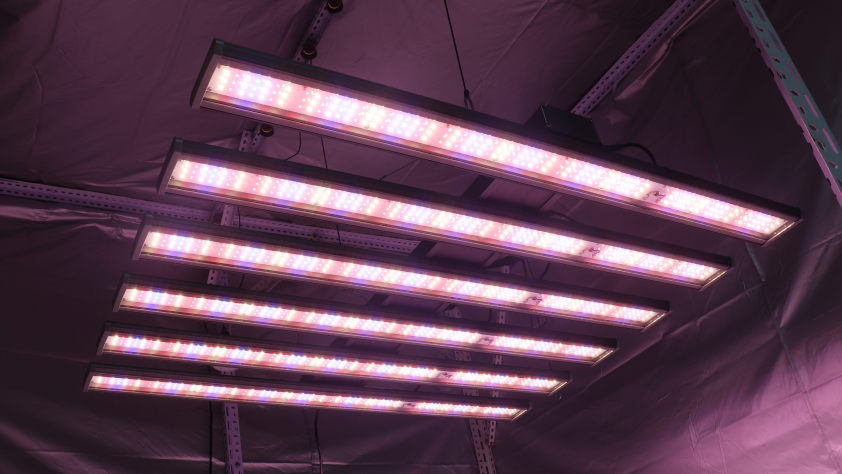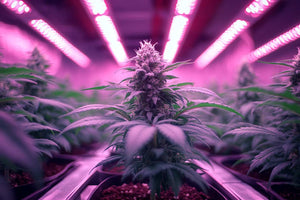The HPS lights, high sodium pressure, have been the most used until today in the cultivation of indoor cannabis. However, with the cost of LED going down and technology of LED improving, growers are growing more with the new LED lights and therefore the LED horticultural lighting industry is expanding rapidly.
In this article we want to put both lighting systems on a scale and assess the advantages and disadvantages of each one of them, hoping that it will be helpful for those who grow indoors.
What are HPS lights?
Growing cannabis with HPS lights
High-Pressure Sodium (HPS) lights operate by channeling a high-voltage pulse through a compact quartz tube, which contains vaporized sodium along with other gases like xenon and mercury. As these gases heat up, they produce light. Sodium is particularly effective at generating a vibrant yellow-orange hue, which is balanced by the cooler blue light emitted by xenon and mercury, resulting in a more balanced, whiter light spectrum.
Historically, HPS lighting systems have been the preferred choice for cannabis cultivation. These systems range in power from 75 to 4,000 watts and are highly effective, providing optimal levels of CBT for cannabis growth and producing an abundant lumen output. Available in various shapes and sizes, HPS lights offer versatility and can be tailored to meet the specific needs of any cannabis grow operation.
The efficiency of HPS lights
The highest performance HPS bulbs produce about 150 lm / W. For example, GE Lucalox 600 bulbs produce 90,000 initial lumens, these initial lumens refer to the average light output in the first 100 hours. In terms of PAR output of wavelength between 400-700nm, a best double-ended 1,000-W HPS lamp with an electronic ballast has a PPE of around 1.7 µmol/J.
HPS light spectrum
Although HPS lighting technology has been improved lately, its daylight imitation is considered to be worse than other newer systems. Since the sodium vapor emits an intense reddish-yellow light, although there are now new full spectrum light bulbs consisting of a double arc system comprising both a metal halide and an HPS component.
Advantages of HPS lights
-
Normally, HPS lamps produce an important stimulation of flowering, so that plants bloom more vigorously, which translates into better yields.
-
Initially, HPS lighting systems have less cost than LEDs.
-
HPS lights are more frequent and standardized, therefore they are easier to handle and you can know better what kind of lighting you are buying.
-
With HPS lights we are providing quality light to plants since it is a very powerful light.
Disadvantages of HPS lights
-
As we have said before they are cheaper than LEDs, but they consume a lot, so their operating cost is quite high, especially when the bulbs are more than 1000W.
-
HPS lighting produces a lot of heat, which does not require adequate ventilation. This heat is not highly recommended for small crops.
-
Frequently they need a ballast or reflector for their operation.
-
Its lifespan is shorter than those of LED lights.
What are the LED lights?

GLMX720 720W Full Spectrum LED Grow Light
The LED lights, light emitting diode, are semiconductors that allow electrical energy with little resistance in one direction and high resistance in the other, pass through a "pnjunction". On one side of the junction, there is a material treated to provide extra electrons, while on the other side there is a material that has been treated to have no electrons.
When voltage is applied, extra electrons move through the junction to fill the "electron holes" on the other side. This allows the light of a color that varies depending on the material used to be emitted. The most commonly used materials are phosphides and gallium nitrides, aluminum, zinc, and silicon.
The efficiency of LED lights
In LED lights the proportion of lumens per watt is less significant than the PAR. This is because the red and blue color has less proportion of lm/W generally because as it provides the most necessary bands for photosynthesis, unnecessary waste of energy is avoided. The PPF for LED products ranges considerably, and many new fixtures now exceed 2.0 µmol/J.
LED lights spectrum
The newest LED lights use multiple bands to create a more complete, more complex and effective spectrum, which is thought to be very beneficial for plant growth and often use white individual LEDs along with some reds and violets. LEDs may provide the best spectrum for plants and the most modern full-spectrum models offer up to 11 bands of wavelengths of light, ideal waves for cultivation.
Advantages of LED lights
-
Today, quality LED lights can provide the same quality and intensity as HPS lights.
-
They produce very little heat, so ventilation may not even be necessary for the growing room.
-
These are energy-efficient lights and do not need as much electricity as HPS lights, so the electricity bills will be lower and the crop will not raise suspicion.
-
LED lights have a very long lifespan, between 50,000 and 100,000 hours.
-
A large number of growers claim that LED lights produce buds of higher quality in flowering, with a considerable increase in potency.
-
No ballast or reflector is necessary for its operation, since they are smaller systems, with the consequent saving of space.
Disadvantages of LED lights
-
At first, they can be very expensive compared to HPS.
-
There is no standardization in the field of LED crop lights.
-
As there is no regulation, we can find cheaper lights but they do not have the same quality, producing less than expected, which gives the LED lights a bad image.
-
Low heat production can become a disadvantage in cold areas, where lighting plays a very important role in maintaining a good temperature.
-
Although the quality of the outbreak is better, generally the LED lights give a lower production in terms of quantity.
Conclusion
As we navigate the landscape of grow lighting, it's evident that each type has its unique advantages and challenges. The focus on the quality of these lights is diminishing as the primary consideration shifts towards aligning with the specific needs of your cultivation. Typically, HPS lights might be the optimal choice for beginner growers with a limited number of plants, mainly due to lower upfront costs. However, for those prioritizing long-term energy efficiency and cost-effectiveness, LED lights emerge as the superior option.
It's important to acknowledge the ongoing transition in grow lighting preferences. HPS lights, once dominant, are gradually being replaced by LEDs. Although both types can yield comparable results, it's crucial to recognize that HPS technology has reached its developmental peak, whereas LED technology continues to evolve. This ongoing advancement in LED technology prompts us to ponder the future possibilities and advancements that await in the field of grow lighting.
Note: The above content is reproduced from VANQ

